Building and Health: Mapping the Knowledge Development of Sick Building Syndrome
Abstract
:1. Introduction
2. Materials and Methods
2.1. Methodology
2.2. Data Retrieval
3. Knowledge Base of SBS Research
3.1. General Statistical Analysis
3.2. Subject Statistical Analysis
3.3. Keywords Statistical Analysis
4. Knowledge Development Trajectory of SBS Research
4.1. Construction of a Citation Network
4.2. Main Research Trajectory in the SBS Domain
4.3. Phased Research Trajectory in the SBS Domain
4.3.1. Research Trajectory between 1984 and 1996
4.3.2. Research Trajectory between 1997 and 2009
4.3.3. Research Trajectory between 2010 and 2022
5. Conclusions
- (1)
- Knowledge base. SBS has experienced 38 years of development after first proposed in 1983. Research strength of the United States and Denmark is the strongest, while Uppsala University from Sweden should also not be underestimated. Norback D and Fisk WJ have the highest influence factor, and Indoor Air has the most publication number in this field. From the subject categories involved, SBS was first carried out in medical science, then environmental science after 1987 and engineering construction after 1990. From the research topics involved, the main concerns are physical and psychological diseases of women and children in families or offices and schools, including both corresponding symptoms (e.g., asthma, allergy, etc.) and triggered diseases (e.g., chronic fatigue syndrome, etc.). In addition, risk factors of SBS have also drawn attention, including air pollution, microbial and climatic factors and the improvement of SBS by increasing building ventilation.
- (2)
- Knowledge development trajectory. Finnegan MJ published the first influential SBS article on British Medical Journal in 1984, investigating causes of SBS from an epidemiological perspective. Since then, various SBS knowledge trajectories have been developed, whether it is the whole domain knowledge trajectory or the phased knowledge trajectory at each stage. Generally speaking, mainstream research in this field has been focusing on the risk factors of SBS. Based on previous studies, scholars supplement risk factors of SBS step by step, which in summary include personal factors, occupational factors, psychosocial factors, building factors (e.g., VOC, formaldehyde and other pollutants) and building related factors (e.g., indoor dust, outdoor climate, etc.). Another research path related to interventions of SBS has shown that office work performance can be improved by different ventilation types (i.e., natural ventilation, mechanical ventilation, air conditioning, etc.) and ventilation rate. The latest research, on the other hand, believes that solutions of SBS should be committed at the architectural design stage with the purpose of making it more consistent with the behaviors, preferences, health and well-being of occupants, providing novel concept and development direction for the study of SBS.
Author Contributions
Funding
Institutional Review Board Statement
Informed Consent Statement
Data Availability Statement
Conflicts of Interest
Appendix A
| Documents | Title | Journal | DOI |
|---|---|---|---|
| Burge S, 1987 | Sick building syndrome—A study of 4373 office workers | Annals of Occupational Hygiene | 10.1093/annhyg/31.4A.493 |
| Skov P, 1989 | Influence of personal characteristics, job-related factors and psychosocial factors on the sick building syndrome | Scandinavian Journal of Work Environment & Health | 10.5271/sjweh.1851 |
| Finnegan MJ, 1984 | The sick building syndrome—prevalence studies | British Medical Journal | 10.1136/bmj.289.6458.1573 |
| Skov P, 1987 | The sick building syndrome in the office environment—the danish town hall study | Environment International | 10.1016/0160-4120(87)90190-5 |
| Redlich CA, 1997 | Sick-building syndrome | Lancet | 10.1016/S0140-6736(96)07220-0 |
| Skov P, 1990 | Influence of indoor climate on the sick building syndrome in an office environment | Scandinavian Journal of Work Environment & Health | 10.5271/sjweh.1772 |
| Norback D, 1991 | Environmental, occupational, and personal factors related to the prevalence of sick building syndrome in the general population | British Journal of Industrial Medicine | Unknown |
| Norback D, 1990 | Volatile organic-compounds, respirable dust, and personal factors related to prevalence and incidence of sick building syndrome in primary-schools | British Journal of Industrial Medicine | Unknown |
| Norback D, 1990 | Indoor air-quality and personal factors related to the sick building syndrome | Scandinavian Journal of Work Environment & Health | 10.5271/sjweh.1808 |
| Apter A, 1994 | Epidemiology of the sick building syndrome | Journal of Allergy and Clinical Immunology | 10.1016/0091-6749(94)90087-6 |
| Wolkoff P, 2013 | Indoor air pollutants in office environments: Assessment of comfort, health, and performance | International Journal of Hygiene and Environmental Health | 10.1016/j.ijheh.2012.08.001 |
| Wargocki P, 2002 | Ventilation and health in non-industrial indoor environments: report from a European Multidisciplinary Scientific Consensus Meeting (EUROVEN) | Indoor Air | 10.1034/j.1600-0668.2002.01145.x |
| Ghaffarianhoseini A, 2018 | Sick building syndrome: are we doing enough? | Architectural Science Review | 10.1080/00038628.2018.1461060 |
| Lim FL, 2015 | Sick building syndrome (SBS) among office workers in a Malaysian university—Associations with atopy, fractional exhaled nitric oxide (feno) and the office environment | Science of the Total Environment | 10.1016/j.scitotenv.2015.06.137 |
| Wolkoff P, 2008 | “Healthy” eye in office-like environments | Environment International | 10.1016/j.envint.2008.04.005 |
| Lu C, 2016 | Outdoor air pollution, meteorological conditions and indoor factors in dwellings in relation to sick building syndrome (SBS) among adults in China | Science of the Total Environment | 10.1016/j.scitotenv.2016.04.033 |
| Borchers AT, 2006 | Airborne environmental injuries and human health | Clinical Reviews in Allergy & Immunology | 10.1385/CRIAI:31:1:1 |
| Norback D, 2009 | An update on sick building syndrome | Current Opinion in Allergy and Clinical Immunology | 10.1097/ACI.0b013e32831f8f08 |
| Kuhn DM, 2003 | Indoor mold, toxigenic fungi, and Stachybotrys chartarum: Infectious disease perspective | Clinical Microbiology Reviews | 10.1128/CMR.16.1.144-172.2003 |
| Wolkoff P, 2007 | The dichotomy of relative humidity on indoor air quality | Environment International | 10.1016/j.envint.2007.04.004 |
| Burge PS, 2004 | Sick building syndrome | Occupational and Environmental Medicine | 10.1136/oem.2003.008813 |
| Wolkoff P, 1997 | Are we measuring the relevant indoor pollutants? | Indoor Air | 10.1111/j.1600-0668.1997.t01-2-00003.x |
| Hodgson M, 2000 | Sick building syndrome | Occupational Medicine-State of the Art Reviews | Unknown |
| Wolkoff P, 2006 | Organic compounds in office environments—Sensory irritation, odor, measurements and the role of reactive chemistry | Indoor Air | 10.1111/j.1600-0668.2005.00393.x |
References
- Awada, M.; Becerik-Gerber, B.; Hoque, S.; O’Neill, Z.; Pedrielli, G.; Wen, J.; Wu, T. Ten questions concerning occupant health in buildings during normal operations and extreme events including the COVID-19 pandemic. Build. Environ. 2021, 188, 107480. [Google Scholar] [CrossRef]
- Licina, D.; Yildirim, S. Occupant satisfaction with indoor environmental quality, sick building syndrome (sbs) symptoms and self-reported productivity before and after relocation into well-certified office buildings. Build. Environ. 2021, 204, 108183. [Google Scholar] [CrossRef]
- World Health Organization. WHO Housing and Health Guidelines. Available online: https://www.who.int/publications/i/item/9789241550376 (accessed on 20 December 2021).
- Cheng, B.; Lu, K.; Li, J.; Chen, H.; Luo, X.; Shafique, M. Comprehensive assessment of embodied environmental impacts of buildings using normalized environmental impact factors. J. Clean. Prod. 2021, 334, 130083. [Google Scholar] [CrossRef]
- Phillips, H.; Handy, R.; Sleeth, D.; Thiese, M.S.; Schaefer, C.; Stubbs, J. Taking the “LEED” In indoor air quality: Does certification result in healthier buildings? J. Green Build. 2020, 15, 55–66. [Google Scholar] [CrossRef]
- Baloch, R.M.; Maesano, C.N.; Christoffersen, J.; Banerjee, S.; Gabriel, M.; Csobod, E.; Fernandes, E.D.; Annesi-Maesano, I.; Csobod, E.E.; Szuppinger, P. Indoor air pollution, physical and comfort parameters related to schoolchildren’s health: Data from the european sinphonie study. Sci. Total Environ. 2020, 739, 139870. [Google Scholar] [CrossRef] [PubMed]
- Gao, X.M.; Jali, Z.M.; Aziz, A.R.A.; Hizaddin, H.F.; Buthiyappan, A.; Jewaratnam, J.; Bello, M.M. Inherent health oriented design for preventing sick building syndrome during planning stage. J. Build. Eng. 2021, 44, 103285. [Google Scholar] [CrossRef]
- Aigbavboa, C.; Thwala, W.D. Performance of a green builidng’s indoor environmental quality on building occupants in South Africa. J. Green Build. 2019, 14, 131–147. [Google Scholar] [CrossRef]
- Jones, A.P. Indoor air quality and health. Atmos. Environ. 1999, 33, 4535–4564. [Google Scholar] [CrossRef]
- Vardoulakis, S.; Giagloglou, E.; Steinle, S.; Davis, A.; Sleeuwenhoek, A.; Galea, K.S.; Dixon, K.; Crawford, J.O. Indoor exposure to selected air pollutants in the home environment: A systematic review. Int. J. Environ. Res. Pub. Health 2020, 17, 8972. [Google Scholar] [CrossRef]
- Nordin, S. Mechanisms underlying nontoxic indoor air health problems: A review. Int. J. Hyg. Environ. Health 2020, 226, 113489. [Google Scholar] [CrossRef]
- Tran, V.V.; Park, D.; Lee, Y.C. Indoor air pollution, related human diseases, and recent trends in the control and improvement of indoor air quality. Int. J. Environ. Res. Public Health 2020, 17, 2927. [Google Scholar] [CrossRef] [PubMed] [Green Version]
- Fisk, W.J. How home ventilation rates affect health: A literature review. Indoor Air 2018, 28, 473–487. [Google Scholar] [CrossRef] [PubMed] [Green Version]
- Hummon, N.P.; Doreian, P. Connectivity in a citation network: The development of DNA theory. Soc. Netw. 1989, 11, 39–63. [Google Scholar] [CrossRef]
- Batagelj, V. Efficient algorithms for citation network analysis. arXiv 2003, arXiv:Cs/0309023. [Google Scholar]
- Henrique, B.M.; Sobreiro, V.A.; Kimura, H. Building direct citation networks. Scientometrics 2018, 115, 817–832. [Google Scholar] [CrossRef]
- Fu, H.L.; Wang, M.M.; Li, P.; Jiang, S.; Hu, W.; Guo, X.T.; Cao, M. Tracing knowledge development trajectories of the internet of things domain: A main path analysis. IEEE Trans. Ind. Inf. 2019, 15, 6531–6540. [Google Scholar] [CrossRef]
- Toth, I.; Lazar, Z.I.; Varga, L.; Jarai-Szabo, F.; Papp, I.; Florian, R.V.; Ercsey-Ravasz, M. Mitigating ageing bias in article level metrics using citation network analysis. J. Inf. 2021, 15, 101105. [Google Scholar] [CrossRef]
- Bergefurt, L.; Weijs-Perree, M.; Appel-Meulenbroek, R.; Arentze, T. The physical office workplace as a resource for mental health-a systematic scoping review. Build. Environ. 2022, 207, 108505. [Google Scholar] [CrossRef]
- Sun, Y.X.; Hou, J.; Cheng, R.S.; Sheng, Y.; Zhang, X.Y.; Sundell, J. Indoor air quality, ventilation and their associations with sick building syndrome in chinese homes. Energ. Build. 2019, 197, 112–119. [Google Scholar] [CrossRef]
- Finnegan, M.J.; Pickering, C.A.C.; Burge, P.S. The sick building syndrome—Prevalence studies. Brit. Med. J. 1984, 289, 1573–1575. [Google Scholar] [CrossRef] [Green Version]
- Burge, S.; Hedge, A.; Wilson, S.; Bass, J.H.; Robertson, A. Sick building syndrome—A study of 4373 office workers. Ann. Occup. Hyg. 1987, 31, 493–504. [Google Scholar] [PubMed]
- Norback, D.; Michel, I.; Widstrom, J. Indoor air- quality and personal factors related to the sick building syndrome. Scand. J. Work Environ. Health 1990, 16, 121–128. [Google Scholar] [CrossRef] [PubMed]
- Norback, D.; Torgen, M.; Edling, C. Volatile organic- compounds, respirable dust, and personal factors related to prevalence and incidence of sick building syndrome in primary- schools. Br. J. Ind. Med. 1990, 47, 733–741. [Google Scholar] [CrossRef] [PubMed] [Green Version]
- Skov, P.; Valbjorn, O. The sick building syndrome in the office environment—The Danish town hall study. Environ. Int. 1987, 13, 339–349. [Google Scholar] [CrossRef]
- Skov, P.; Valbjorn, O.; Pedersen, B.V. Influence of personal characteristics, job-related factors and psychosocial factors on the sick building syndrome. Scand. J. Work Environ. Health 1989, 15, 286–295. [Google Scholar] [CrossRef]
- Skov, P.; Valbjorn, O.; Pedersen, B.V. Influence of indoor climate on the sick building syndrome in an office environment. Scand. J. Work Environ. Health 1990, 16, 363–371. [Google Scholar] [CrossRef] [Green Version]
- Norback, D.; Edling, C. Environmental, occupational, and personal factors related to the prevalence of sick building syndrome in the general-population. Br. J. Ind. Med. 1991, 48, 451–462. [Google Scholar] [CrossRef] [Green Version]
- Teeuw, K.B.; Vandenbrouckegrauls, C.M.J.E.; Verhoef, J. Airborne gram-negative bacteria and endotoxin in sick building syndrome- A study on Dutch governmental office buildings. Arch. Intern. Med. 1994, 154, 2339–2345. [Google Scholar] [CrossRef]
- Redlich, C.A.; Sparer, J.; Cullen, M.R. Sick- building syndrome. Lancet 1997, 349, 1013–1016. [Google Scholar] [CrossRef]
- Bjornsson, E.; Janson, C.; Norback, D.; Boman, G. Symptoms related to the sick building syndrome in a general population sample: Associations with atopy, bronchial hyper- responsiveness and anxiety. Int. J. Tuberc. Lung Dis. 1998, 2, 1023–1028. [Google Scholar]
- Runeson, R.; Wahlstedt, K.; Wieslander, G.; Norback, D. Personal and psychosocial factors and symptoms compatible with sick building syndrome in the Swedish workforce. Indoor Air 2006, 16, 445–453. [Google Scholar] [CrossRef] [PubMed]
- Menzies, R.; Tamblyn, R.; Farant, J.P.; Hanley, J.; Nunes, F.; Tamblyn, R. The effect of varying levels of outdoor- Air supply on the symptoms of sick building syndrome. N. Engl. J. Med. 1993, 328, 821–827. [Google Scholar] [CrossRef] [PubMed]
- Stenberg, B.; Eriksson, N.; Hoog, J.; Sundell, J.; Wall, S. The sick- building—syndrome(SBS) in office- workers—A case-referent study of personal, psychosocial and building- related risk indicators. Int. J. Epidemiol. 1994, 23, 1190–1197. [Google Scholar] [CrossRef] [PubMed]
- Seppanen, O.A.; Fisk, W.J.; Mendell, M.J. Association of ventilation rates and CO2 concentrations with health andother responses in commercial and institutional buildings. Indoor Air 1999, 9, 226–252. [Google Scholar] [CrossRef]
- Wargocki, P.; Wyon, D.P.; Sundell, J.; Clausen, G.; Fanger, P.O. The effects of outdoor air supply rate in an office on perceived air quality, Sick Building Syndrome (SBS) symptoms and productivity. Indoor Air 2000, 10, 222–236. [Google Scholar] [CrossRef] [PubMed]
- Wargocki, P.; Sundell, J.; Bischof, W.; Brundrett, G.; Fanger, P.O.; Gyntelberg, F.; Hanssen, S.O.; Harrison, P.; Pickering, A.; Seppanen, O.; et al. Ventilation and health in non-industrial indoor environments: Report from a European Multidisciplinary Scientific Consensus Meeting (EUROVEN). Indoor Air 2002, 12, 113–128. [Google Scholar] [CrossRef] [PubMed]
- Norback, D. An update on sick building syndrome. Curr. Opin. Allergy CL 2009, 9, 55–59. [Google Scholar] [CrossRef]
- Sahlberg, B.; Gunnbjornsdottir, M.; Soon, A.; Jogi, R.; Gislason, T.; Wieslander, G.; Janson, C.; Norback, D. Airborne molds and bacteria, microbial volatile organic compounds (MVOC), plasticizers and formaldehyde in dwellings in three North European cities in relation to sick building syndrome (SBS). Sci. Total Environ. 2013, 444, 433–440. [Google Scholar] [CrossRef]
- Lu, C.; Deng, Q.H.; Li, Y.G.; Sundell, J.; Norback, D. Outdoor air pollution, meteorological conditions and indoor factors in dwellings in relation to sick building syndrome (SBS) among adults in China. Sci. Total Environ. 2016, 560, 186–196. [Google Scholar] [CrossRef] [Green Version]
- Ghaffarianhoseini, A.; AlWaer, H.; Omrany, H.; Ghaffarianhoseini, A.; Alalouch, C.; Clements-Croome, D.; Tookey, J. Sick building syndrome: Are we doing enough? Archit. Sci. Rev. 2018, 61, 99–121. [Google Scholar] [CrossRef] [Green Version]
- Gyntelberg, F.; Suadicani, P.; Nielsen, J.W.; Skov, P.; Valbjorn, O.; Nielsen, P.A.; Schneider, T.; Jorgensen, O.; Wolkoff, P.; Wilkins, C.K.; et al. Dust and the sick building syndrome. Indoor Air 1994, 4, 223–238. [Google Scholar] [CrossRef]
- Nordstrom, K.; Norback, D.; Akselsson, R. Effect of air humidification on the sick building syndrome and perceived indoor air- quality in hospitals—A 4 month longitudinal- study. Occup. Environ. Med. 1994, 51, 683–688. [Google Scholar] [CrossRef] [PubMed] [Green Version]
- Wargocki, P.; Wyon, D.P.; Baik, Y.K.; Clausen, G.; Fanger, P.O. Perceived air quality, Sick Building Syndrome (SBS) symptoms and productivity in an office with two different pollution loads. Indoor Air 1999, 9, 165–179. [Google Scholar] [CrossRef] [PubMed]
- Apte, M.G.; Fisk, W.J.; Daisey, J.M. Associations between indoor CO2 concentrations and sick building syndrome symptoms in US office buildings: An analysis of the 1994–1996 BASE study data. Indoor Air 2000, 10, 246–257. [Google Scholar] [CrossRef] [Green Version]
- Takigawa, T.; Wang, B.L.; Saijo, Y.; Morimoto, K.; Nakayama, K.; Tanaka, M.; Shibata, E.; Yoshimura, T.; Chikara, H.; Ogino, K.; et al. Relationship between indoor chemical concentrations and subjective symptoms associated with sick building syndrome in newly built houses in Japan. Int. Arch. Occup. Environ. Health 2010, 83, 225–235. [Google Scholar] [CrossRef]
- Araki, A.; Kawai, T.; Eitaki, Y.; Kanazawa, A.; Morimoto, K.; Nakayama, K.; Shibata, E.; Tanaka, M.; Takigawa, T.; Yoshimura, T.; et al. Relationship between selected indoor volatile organic compounds, so-called microbial VOC, and the prevalence of mucous membrane symptoms in single family homes. Sci. Total Environ. 2010, 408, 2208–2215. [Google Scholar] [CrossRef] [Green Version]
- AlWaer, H.; Speedie, J.; Cooper, I. Unhealthy Neighbourhood “Syndrome”: A Useful Label for Analysing and Providing Advice on Urban Design Decision-Making? Sustainavility 2021, 13, 6232. [Google Scholar] [CrossRef]
- Guo, X.T.; Fan, Z.Y.; Zhu, H.; Chen, X.Y.; Wang, M.M.; Fu, H.L. Willingness to Pay for Healthy Housing during the COVID-19 Pandemic in China: Evidence from Eye Tracking Experiment. Front. Public Health 2022. [Google Scholar]
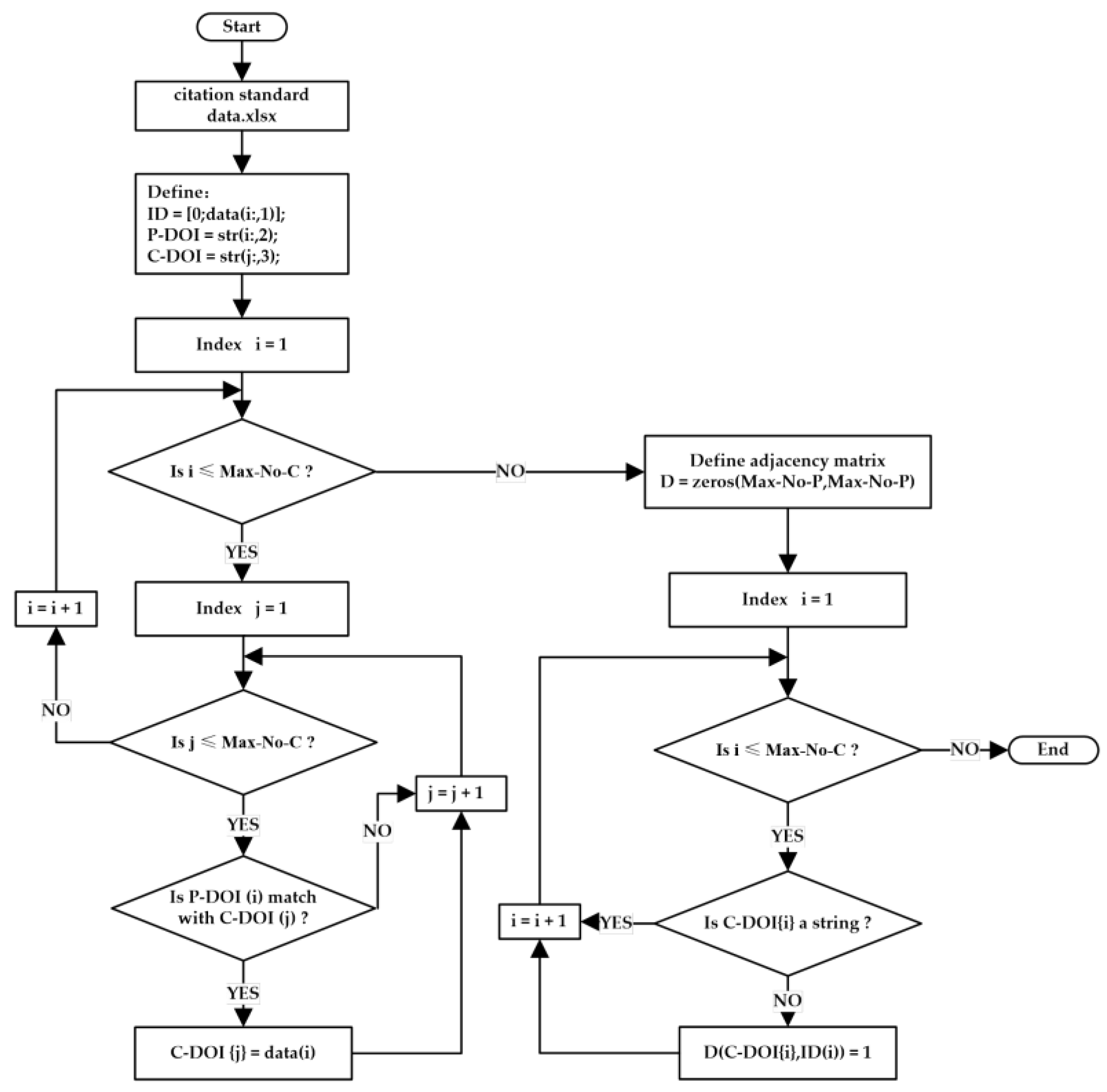
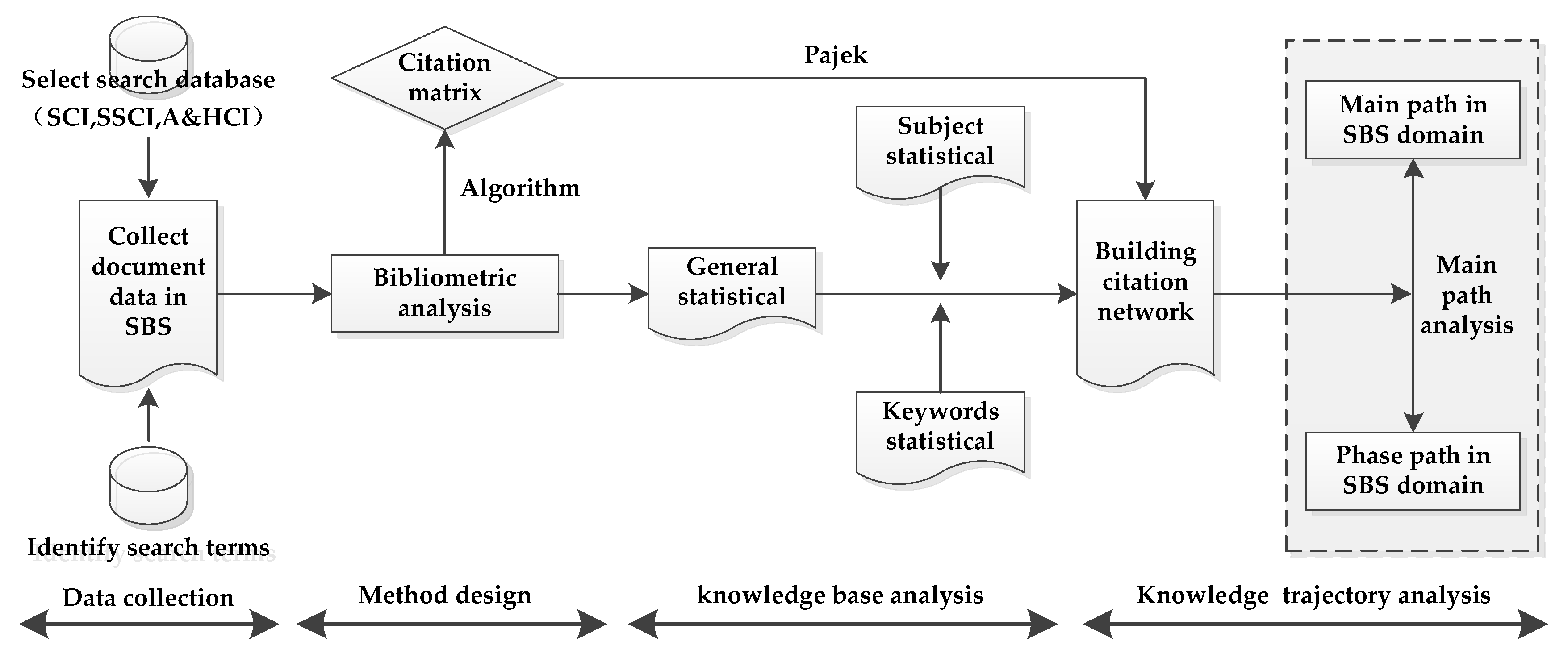
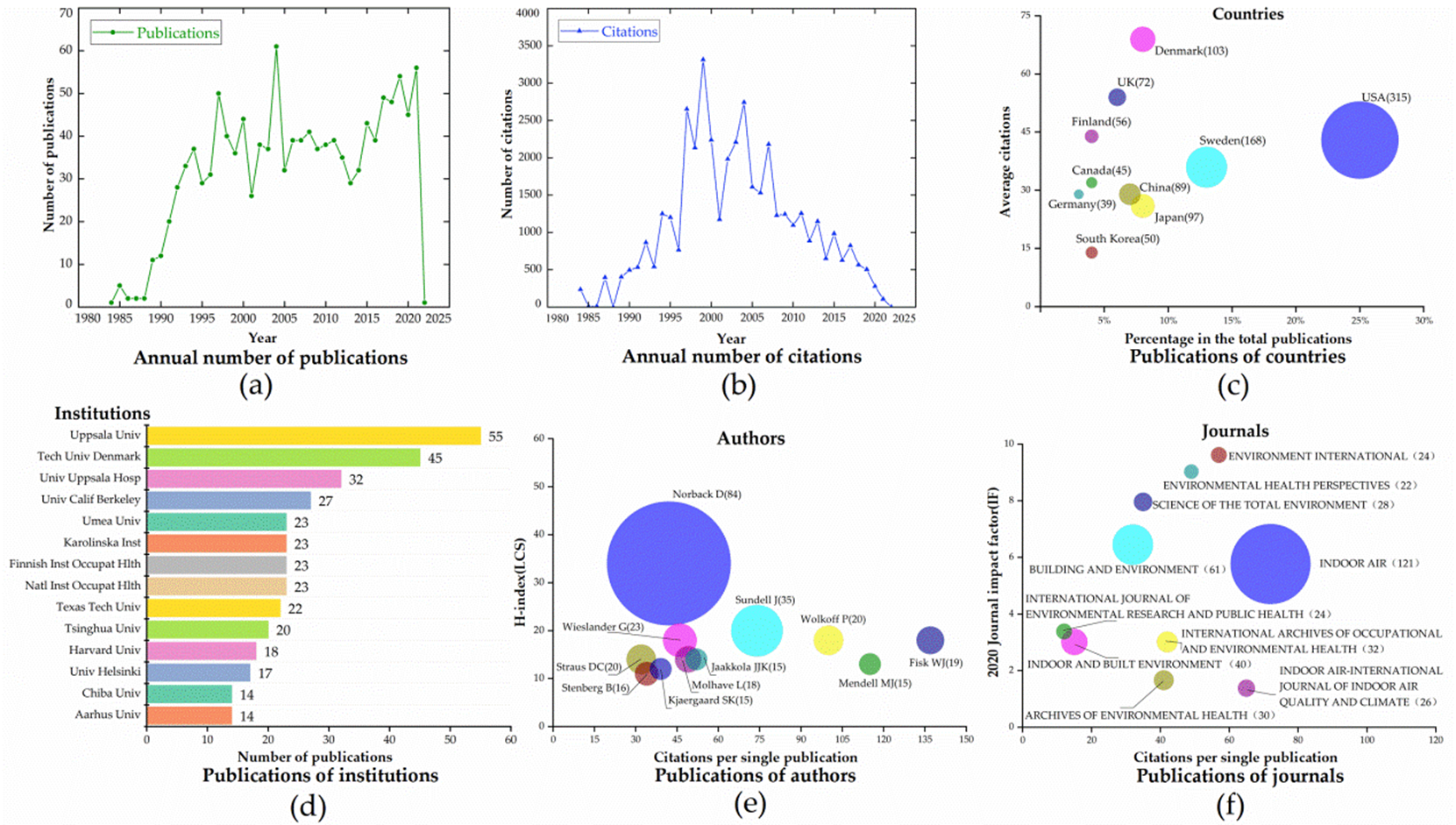
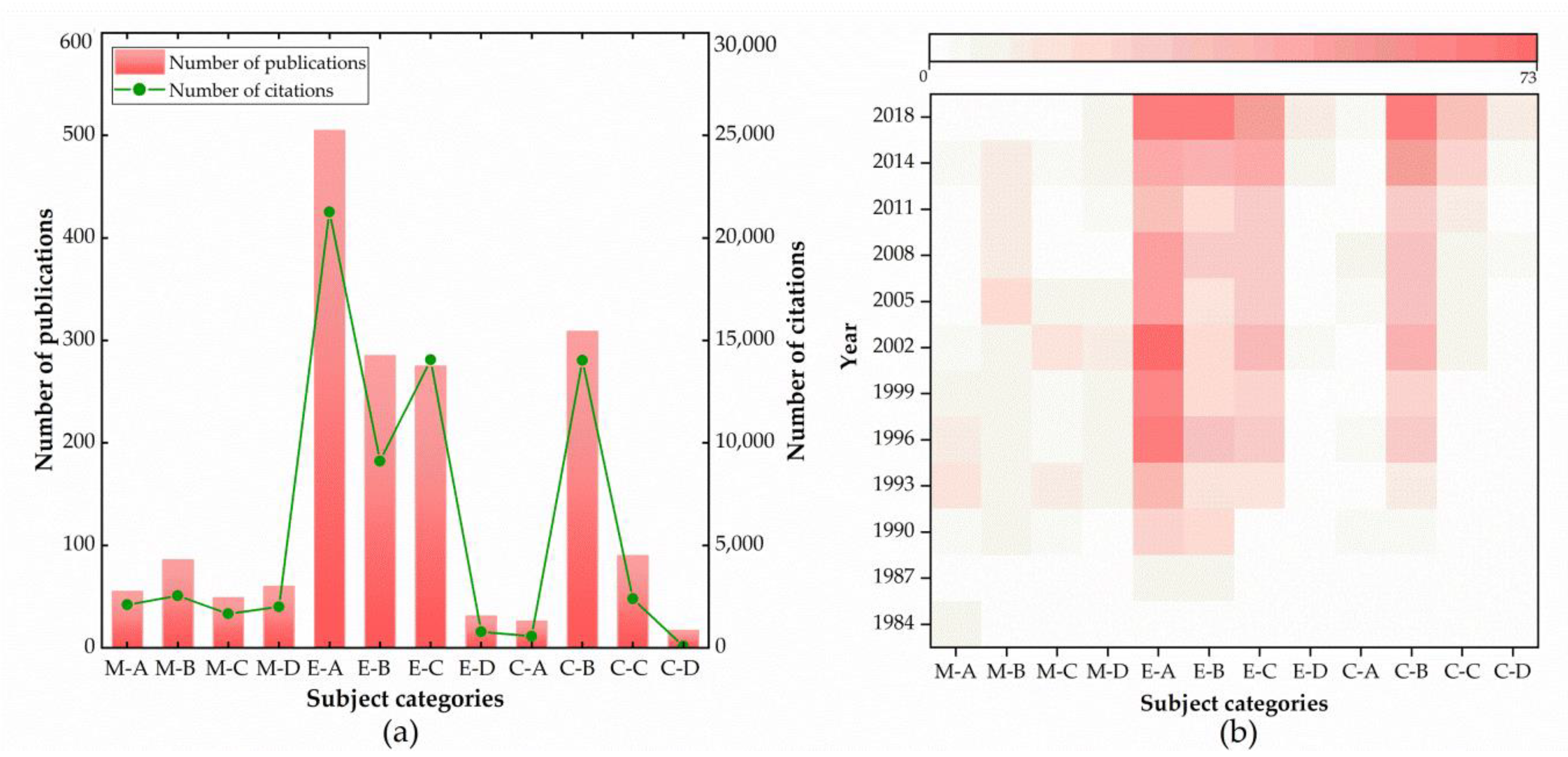
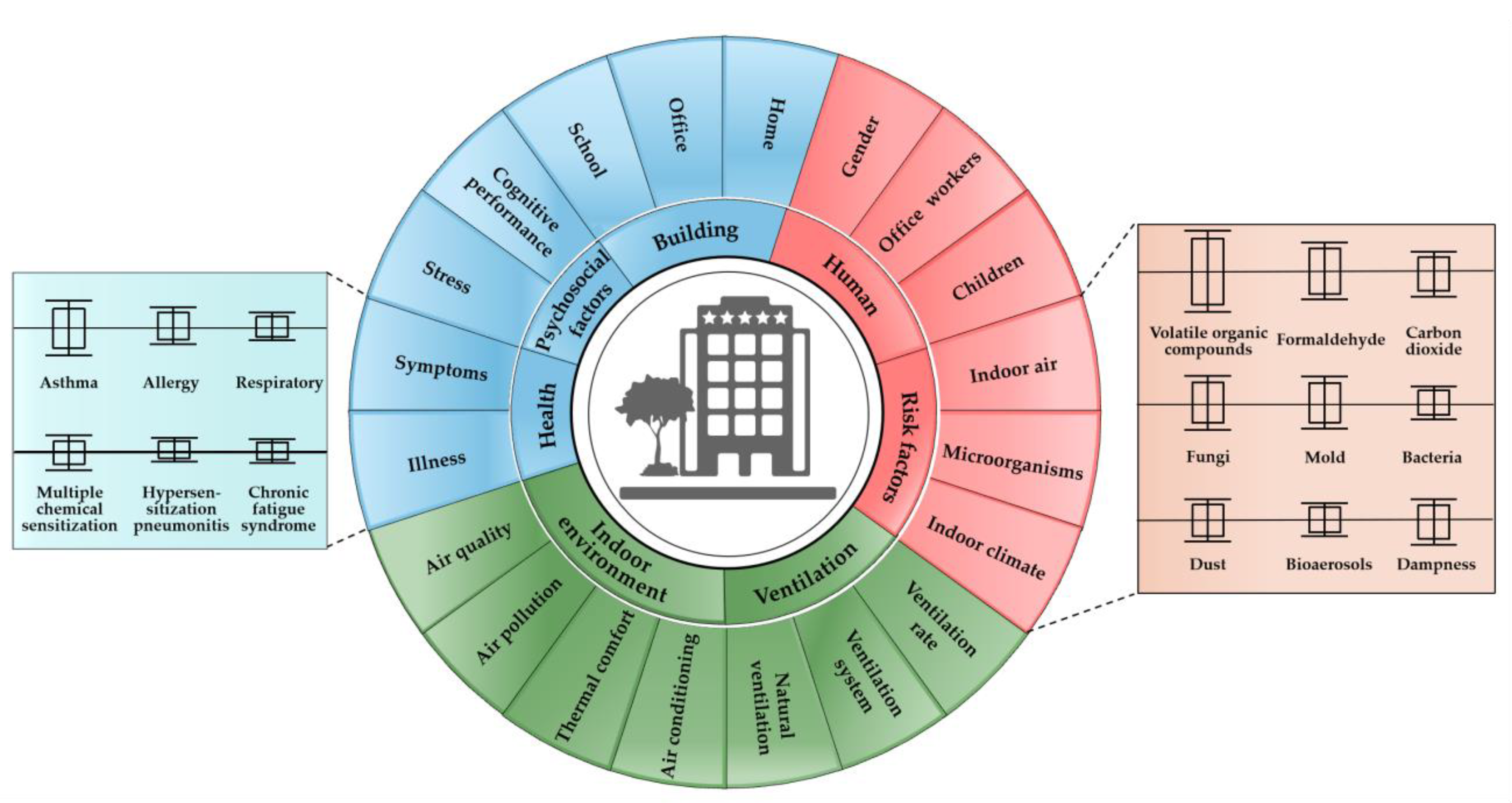
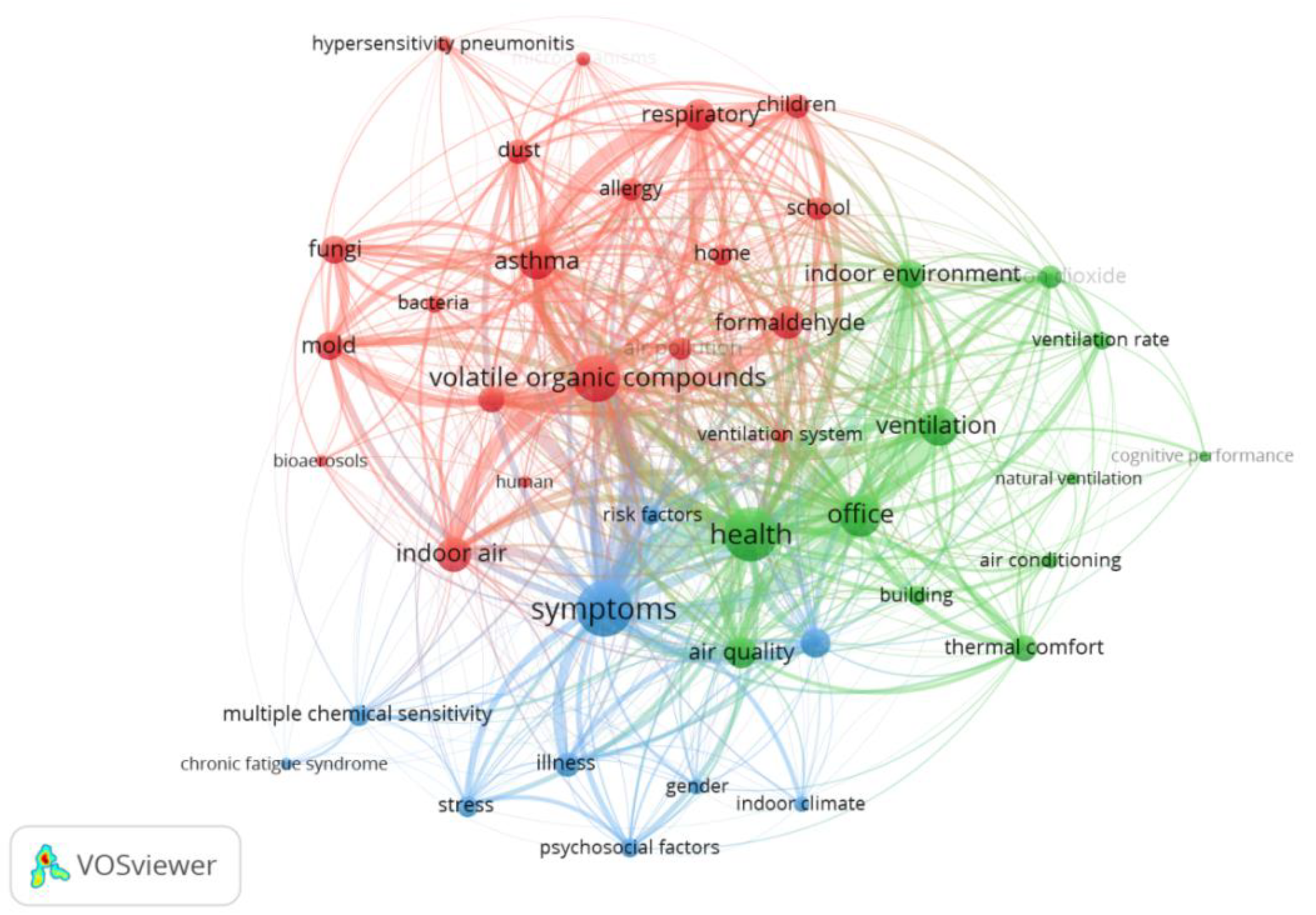

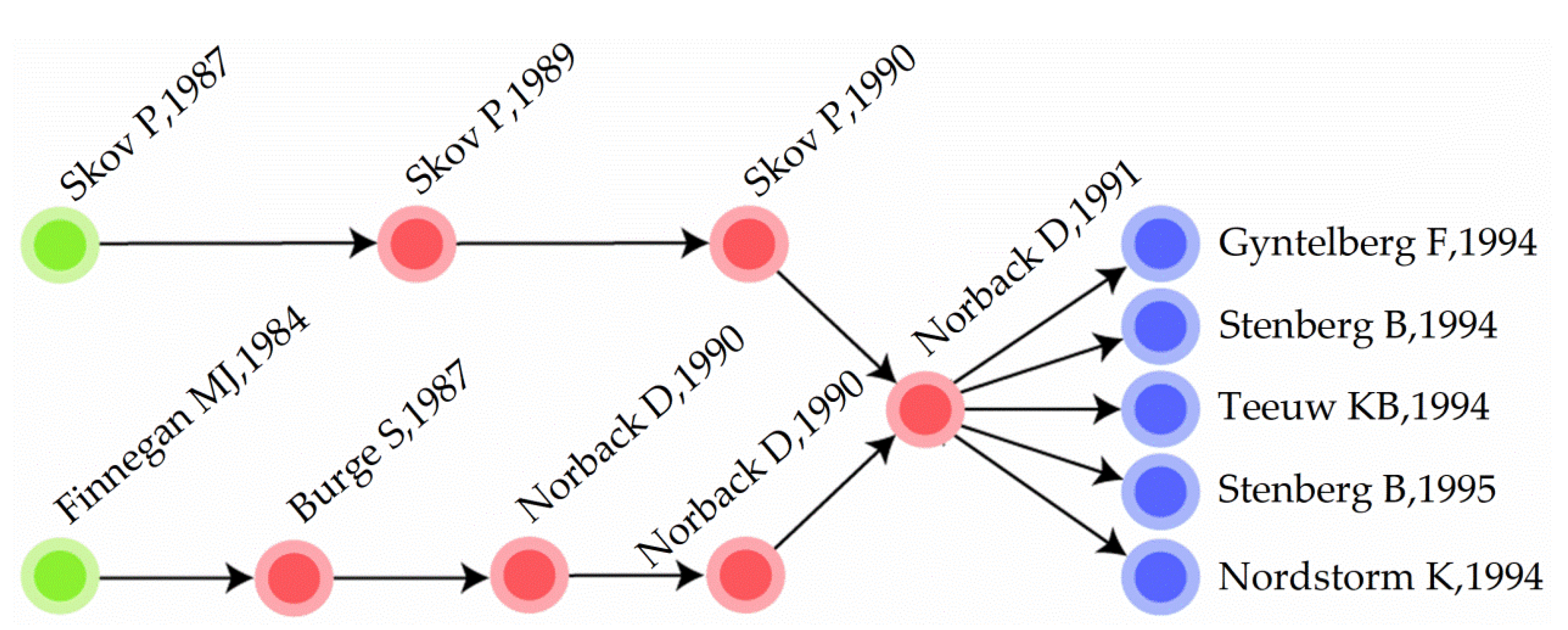
| Search Item | Search Content |
|---|---|
| Search Topic | “sick building syndrome” |
| Search Language | English |
| Search Indexes | SCI-EXPANDED, SSCI, A&HCI |
| Search Timespan | All years |
| Search Results | 1245 records |
| Data Acquisition Time | 28 October 2021 |
| Output Degree | Input Degree | Betweenness Centrality | |||
|---|---|---|---|---|---|
| Documents | Value | Documents | Value | Documents | Value |
| Burge S, 1987 | 147 | Wolkoff P, 2013 | 52 | Norback D, 2009 | 0.014658 |
| Skov P, 1989 | 117 | Wargocki P, 2002 | 45 | Wolkoff P, 2008 | 0.006740 |
| Finnegan MJ, 1984 | 113 | Ghaffarianhoseini A, 2018 | 40 | Burge PS, 2004 | 0.006356 |
| Skov P, 1987 | 113 | Lim FL, 2015 | 38 | Kuhn DM, 2003 | 0.004649 |
| Redlich CA, 1997 | 109 | Wolkoff P, 2008 | 33 | Wargocki P, 2002 | 0.004171 |
| Skov P, 1990 | 93 | Lu C, 2016 | 32 | Wolkoff P, 1997 | 0.004169 |
| Norback D, 1991 | 92 | Borchers AT, 2006 | 31 | Wolkoff P, 2013 | 0.004121 |
| Norback D, 1990 | 91 | Norback D, 2009 | 30 | Hodgson M, 2000 | 0.003647 |
| Norback D, 1990 | 77 | Kuhn DM, 2003 | 30 | Wolkoff P, 2006 | 0.003633 |
| Apter A, 1994 | 74 | Wolkoff P, 2007 | 30 | Ghaffarianhoseini A, 2018 | 0.003537 |
Publisher’s Note: MDPI stays neutral with regard to jurisdictional claims in published maps and institutional affiliations. |
© 2022 by the authors. Licensee MDPI, Basel, Switzerland. This article is an open access article distributed under the terms and conditions of the Creative Commons Attribution (CC BY) license (https://creativecommons.org/licenses/by/4.0/).
Share and Cite
Wang, M.; Li, L.; Hou, C.; Guo, X.; Fu, H. Building and Health: Mapping the Knowledge Development of Sick Building Syndrome. Buildings 2022, 12, 287. https://doi.org/10.3390/buildings12030287
Wang M, Li L, Hou C, Guo X, Fu H. Building and Health: Mapping the Knowledge Development of Sick Building Syndrome. Buildings. 2022; 12(3):287. https://doi.org/10.3390/buildings12030287
Chicago/Turabian StyleWang, Mengmeng, Lili Li, Caixia Hou, Xiaotong Guo, and Hanliang Fu. 2022. "Building and Health: Mapping the Knowledge Development of Sick Building Syndrome" Buildings 12, no. 3: 287. https://doi.org/10.3390/buildings12030287
APA StyleWang, M., Li, L., Hou, C., Guo, X., & Fu, H. (2022). Building and Health: Mapping the Knowledge Development of Sick Building Syndrome. Buildings, 12(3), 287. https://doi.org/10.3390/buildings12030287









